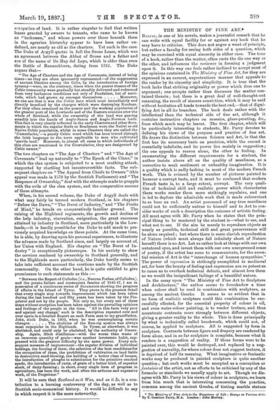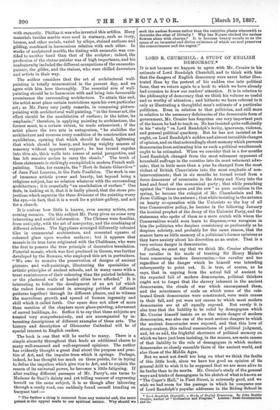THE MINISTRY OF FINE ART.*
BALZ AC, in one of his novels, makes a journalist remark that he can write with equal facility for or against any book that he may have to criticise. This does not argue a want of principle, but rather a faculty for seeing both sides of a question, which may be exercised with equal sincerity in either case. The tone of a book, rather than the matter, often casts the die one way or the other, and influences the reviewer in forming a judgment upon it. In this way one feels rather inclined to accept most of the opinions contained in The Ministry of Fine Art, for they are expressed in an earnest, unpretentious manner that appeals to the reader by its sincerity and simplicity. It is true that the book lacks that striking originality or power which fires one to argument; one accepts rather than discusses the matter con- tained therein ; bat there is a great deal of well-thought-out reasoning, the result of sincere conviction, which it may be said without hesitation all tends towards the best end,—that of digni- fying Art in all its branches. The book deals rather with the intellectual than the technical side of fine art, although it contains instructive chapters on mosaics, glass-painting, &c., from which much may be learnt. The first chapter, which will be particularly interesting to students, Mr. Parry devotes to defining his views of the purpose and practice of fine art. He draws the distinction between Science and Art, in that the first has its necessary basis on precision, while the second is essentially indefinite, and its power lies mainly in suggestion ; the one appeals to reason alone, the other to feeling. In enumerating the different requirements for a student, the anther insists above all on the quality of manliness, as a corrective to weak sentiment or unhealthy imagination. It is a quality which is sadly lacking in most of the modern French work. This is evinced by the number of pictures painted to humour a corrupt taste, and it must be confessed that modern French taste is, to a large extent, corrupt. The very quali- ties of technical skill and realistic power which characterise these works render them more strikingly repulsive, and one is led to deplore the admirable work that is made subservient to so base an end. An artist possessed of any true manliness could not be sufficiently untrue to himself and to Art to con- sider works of such a description the outcome of artistic feeling. All most agree with Mr. Parry when he states that the prin- cipal thing to be mastered by the student is—what to see, and what not to see. If the aim be merely to reproduce objects as nearly as possible, technical skill and great perseverance will be alone required ; but where there is mere slavish reproduction of Nature (which most always fall infinitely short of Nature herself) there is no Art. Let us rather look at things with our own untutored eyes, and invest them with our own unexpressed sense of poetry, if the artist has none to communicate, for the essen- tial mission of Art is the "interchange of human sympathies." The power of expresirion is strikingly exemplified in mediasval art, for here the beauty of feeling and expression are so potent as to cause as to overlook technical defects, and almost love them as we would the insignificant failings of a beautiful nature.
In the essay upon "The Ministry of Fine Art to Sculpture and Architecture," the author seems to foreshadow a time when colour shall be need in combination with sculpture, as among the ancient Greeks. It seems to ns evident that in no form of realistic sculpture could this combination be suc- cessfully effected, for the essential property of colour in oil, and even water-colour painting, is to render texture, and thus accentuate contrasts more strongly between different objects, giving a greater reality to the whole. This is done principally by what is technically called brushwork, which could not, of course, be applied to sculpture. All is suggested by form in sculpture. Contrast; between figure and drapery are rendered by form alone, and in so far sculpture is complete, because what it renders is a suggestion of reality. If these forms were to be painted over, this would be destroyed, and replaced by a sug- gestion of unreality, for where colour does not suggest texture, it is deprived of half its meaning. What imaginative or fantastic works may be produced in painted sculpture is quite another question ; but such works must be accepted as a conception or fantaisie of the artist, not as efforts to be criticised by any of the formuke or standards we usually apply to art. Though we dis- agree with Mr. Parry in his views of colour in sculpture, we learn from him much that is interesting concerning the practice, common among the ancient Greeks, of tinting marble statues • The Minters of Fills Art to tlio Happiness of We Essays on Various Arts. By T. Gambier Parry, M.A. Loudon Jobe Miirray.
with encaustic. Phidias it was who invented this artifice. Many materials besides marble were used in statuary, such as ivory, bronze, and other metals, varied by alloys, stained surfaces and gilding, combined in harmonious relation with each other. In works of sculptured marble, the tinting with encaustic was con- fided to another hand than that of the sculptor ; indeed, the profession of the statue-painter was of high importance, and his confraternity included the different occupations of the encaustic- painter, the gilder, and the stainer, who were skilled decorators and artists in their way.
The author considers that the art of architectural wall- painting is totally mieconceived in the present day, and we agree with him here thoroughly. The essential aim of wall- painting should be to harmonise with and bring into favourable prominence the surrounding architecture. To attain this end, the artist must place certain restrictions upon his own particular art ; as Mr. Parry very justly remarks, in comparing picture- painting with architectural wall-painting, "in the former art, the effect should be the annihilation of surface; in the latter, its emphasis ;" therefore, in applying painting to architecture, the former must, to a certain extent, be made subservient ; if the artist places the two arts in antagonism, "he stultifies the architecture and reverses every condition of its construction and equilibrium, opening that which should be closed, lightening that which should be heavy, and leaving weighty masses of masonry without apparent support ; he has turned cupolas into thin air, thick walls into scenes of aerial perspective, and has left massive arches to carry the clouds." The truth of these statements is strikingly exemplified in modern French wall- painting. Take, for example, the " Mort de Sainte Geinevieve" of Jean Paul Laurens, in the Paris Panthdon. The work is one of immense artistic power and beauty, but beyond being a religions subject, has no relation whatever with the surrounding architecture ; it is essentially "an annihilation of surface." One feels, in looking at it, that it is badly placed, that the stone pro- jections which separate the three divisions of the painting worry the eye,—in fact, that it is a work for a picture-gallery, and not for a church.
It is curious how little is known, even among artists, con- cerning mosaics. On this subject Mr. Parry gives us some very interesting and useful information. The Chinese were familiar, from antiquity, with the art of marquetry, and the combining of different colours. The Egyptians arranged differently coloured tiles in ornamental architecture, and cemented squares of coloured glass upon wooden surfaces; but it appears that mosaic in its true form originated with the Chaldeans, who were the first to possess the true principle of decorative tesselation. Pictorial mosaic, which was first produced in Greece, was farther developed by the Romans, who employed this art in portraiture. We owe to mosaics the preservation of designs of ancient pictures and wall-paintings, illustrating the specialities of artistic principles of ancient schools, and in many cases with a truer reminiscence of their colouring than the painted lechithon, or the plastered walls of buried cities have afforded." It is interesting to follow the development of an art (of which the rudest form consisted in arranging pebbles of different patterns together) through its different phases, and to witness the marvellous growth and spread of human ingenuity and skill which it called forth. Our space does not allow of more than mention of the chapters upon glass-painting, adornment of sacred buildings, ite. Suffice it to say that these subjects are treated very comprehensively, and are accompanied by in- teresting descriptions of different examples of them arts. The history and description of Gloucester Cathedral will be of special interest to English readers.
The book is one that will be useful to many. There is a (simple sincerity throughout that lends an additional charm to many well-reasoned and well-expressed opinions. The author has evidently thought a great deal about the purpose and prac- tice of Art, and the impulse from which it springs. Perhaps, indeed, he has thought too much on these points, for in trying to define the impulses which give rise to Art, and to explain the reason of its universal power, he becomes a little fatiguing. If after reading different passages of Mr. Parry's, one turns to Madame de Steel's dainty and yet telling manner of expressing herself on the same subject, it is as though after labouring through a sandy road, one suddenly found oneself treading on buoyant turf :—
" The farther a thing is removed from any material end, the more potent is the appeal made to our spiritual nature. Why should we
seek the useless flowers rather than the nutritive plants wherewith to decorate the altar of Divinity P Why has Nature clothed the useless flowers alone with charms P It is because beauty recalls to us the sense of an immortal and divine existence of which oar soul preserves the remembrance and the regret."



































 Previous page
Previous page